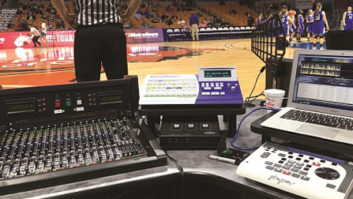As I was weaving amid the bustling crowd of families – eavesdropping whenever possible, of course – one comment from a wife to her husband caught my ear.
“Gee, hon,” she said, “there sure are a lot of radio stations here. I wonder what’s going on?”
The husband shrugged his shoulders as he and the kids wondered where they could get something to drink. This incident occurred during the early days of consolidation. We had decided to have all the stations from our company set up booths at a “co-branded” Kids’ Fair.
We figured we’d put as many there as we could, hoping to give them all more visibility. And if you’re wondering what the problem was, you are not alone.
Don’t get it
Many station groups still don’t understand that when all of them do something together, none of them get to “own” it. Most consumers will simply remember that there “sure were a lot” of radio stations there.
Take the next logical gander and you may conclude, as I have, that whenever we co-brand with sister radio stations – like putting multiple logos on everything from TV spots to T-shirts – we water down the impact of each of our properties in the marketplace.
Why are so many people still confused about this subject? They have not considered carefully enough what they’re attempting to accomplish.
Bull’s eye
For radio stations, the common misuse of internal and external branding typically begins when the marketing director doesn’t think about the target audience of the message.
For example, if your station(s) is (are) interested in reaching either potential corporate employees or advertising clients, then you’ll most want to utilize internal branding.
For this purpose, you could use either your corporate name or the names/logos of all of your stations in the market. The target audience in this case will understand what you’re attempting to accomplish because they’re familiar with your internal brand and would even enjoy hearing you take your corporate sell a bit over the top.
It’s ideal to take this approach if you want to show off the power of your cluster to potential advertisers: “You can reach 1.9 million listeners by advertising with Jumbo-Sized Broadcasting.”
And here’s an example of internal branding for attracting and even keeping employees: “Jumbo-Sized Broadcasting is a great place to work because of this, this, this, this and that.”
Bomb ’em
For your listeners, you’ll almost always want to use external branding. They don’t know who your parent corporation is, nor do they care, because the information contains no benefit for them.
But picture some of your listeners at the next Kids’ Fair where all they see is dozens of logos for only your oldies station. They’re a lot more likely then to recall the product and give that station credit for being present at that event.
Yes, I understand the pickle you are now in. Your parent owner has made it very clear that you’re to “exercise the power of your cluster” with the audience in your market. How can you meet this corporate dictate and do what I’m suggesting?
Be smart. Realize that you can promote events and even sell products through nonbranded means over several stations. How? Let’s go back to the Kids’ Fair example.
We want it to be owned by the oldies station, but promoted on several properties. Easy! Simply call it the “oldies 92.5 Kids’ Fair” when mentioning it on the oldies station. When you mention it on the other stations in your cluster, just refer to it as “The Kids’ Fair.”
This solution can make everyone happy. The Kids’ Fair people you’re working with will feel privileged that you’re using the power of your group to drive audience.
Your corporation will approve that you’re using all your stations. And most importantly, one of the stations in your group can actually benefit by taking ownership of the event. This scenario becomes a lot easier to execute over time as your market leader (executive vice president, market GM – whatever the applicable title) sees that there is an all-win way to split up events, advertising schedules and even specialty items.
Designate a lead station for all market events at the start of the process. Next, make sure each station has its own Web site. If you’ve got a “cluster site” where a consumer “picks” their station from a laundry list, tear that baby down.
Here’s another hint: The pennies you may save on co-branding specialty items – multiple logos on T-shirts, coffee mugs, etc. – are not worth it!
Get rid of your present supply and next time you order, go back to single-station stuff.
Some may see this as my longing to turn back the hands of time on consolidation. I am not. As a matter of fact, not that long ago, AM and FM co-owned stations would make the same mistakes I’m referring to in this article.
It’s just gotten more obvious because so many stations are now co-owned in one market. This is a very simple concept, but before you proceed, take the idea to your leader. If he doesn’t think it sane, ask him to do a little eavesdropping the next time he wants, say, to show off seven or eight logos to consumers.
In this case, his ears may open his mind in a way that would make corporate proud.
Do you have pictures from your last station promotion event? Send them with caption information to GM Journal editor Laura Dely via e-mail toLD@imaspub.com



